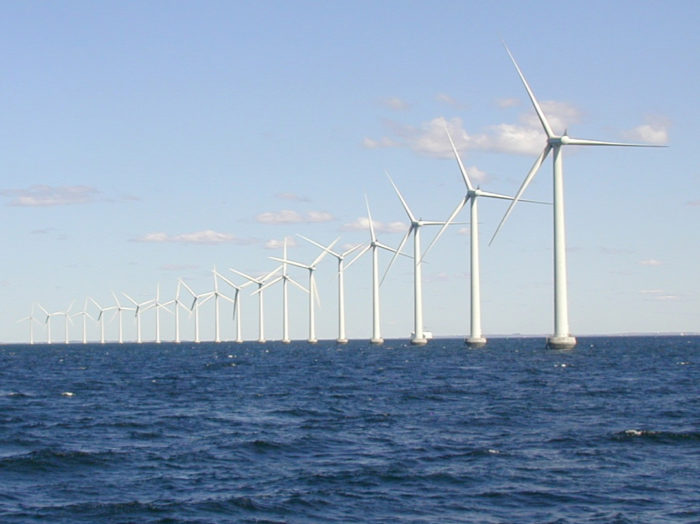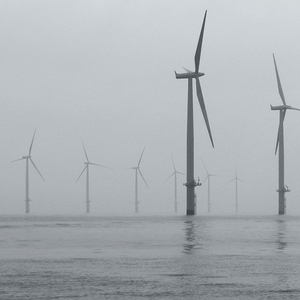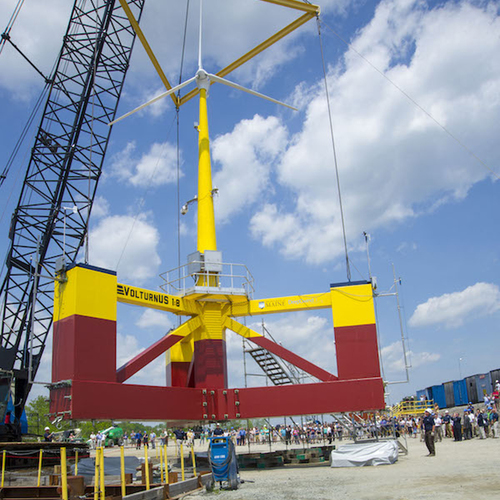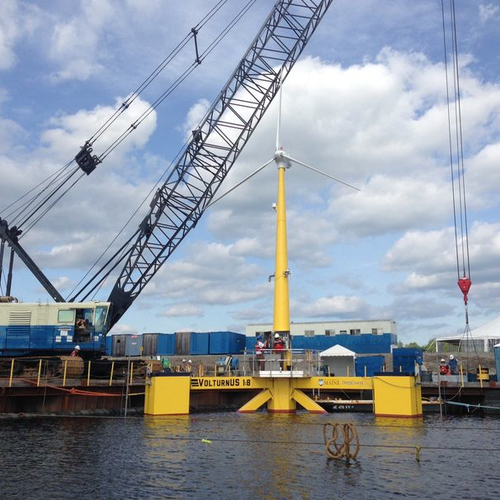
Image Credit: National Renewable Energy Laboratory
It will be small by European standards, but the five-turbine Deepwater Wind project off Rhode Island’s coast is a first in North America and construction is now underway.
On Sunday, the steel foundation for the first turbine was plucked from a transport barge by the Weeks 533, the largest floating revolving crane on the East Coast, and lowered into the waters off Block Island, the Providence Journal reported. The assembly, which weighs about 440 tons, will be pinned to the ocean floor with piles as long as 200 feet.
Jeffrey Grybowski, head of the Providence, Rhode Island, based company, said “it was a very big moment” in the project.
“Our belief is once Block Island is up and running, it will bring offshore wind from theory to reality in the United States and open up opportunities to build larger projects,” he told Reuters.
There are now nearly 2,500 offshore turbines connected to the European grid, but efforts to develop deepwater turbines in the U.S. have been hampered by both cost and aesthetic concerns as well as worries about their impact on ocean life.
The Deepwater project is about three miles off the coast of Block Island, a summer tourist destination, Reuters reported. When compete by the end of 2016, the 30-megawatt wind farm will send about 90% of the electricity it generates to the mainland via undersea cables. National Grid will buy it for 26 cents per kilowatt hour and mix it with the rest of the state’s electricity supply. The output will equal about 1% of the state’s total electricity supply.
On Block Island, originally chosen for the project because of its reliance on diesel-fired generators for its power, electric rates are expected to drop by 40% when the project comes online.
Off to a slow start
A much larger wind project, the 130-turbine Cape Wind, has been proposed for federally owned waters off Cape Cod, Massachusetts, in Nantucket Sound. With a total capacity of 468 megawatts, according to the developers, the wind farm would be capable of producing 75% of the electricity used on Cape Cod and the islands of Martha’s Vineyard and Nantucket.
Construction was due to start by May 1, according to a report in The Boston Globe, but developers asked the state for a two-year extension after the state’s two major utilities backed out of plans to buy electricity from the project.
Construction will cost an estimated $2.6 billion.
Cape Wind has “repeatedly” needed deadline extensions over its 14-year history, the Globe reported, and the project has been the target of intense opposition from offshore wind critics. They include groups like Save Our Sound, whose website lists a variety of economic and environmental reasons why the project should be blocked.
The ultimate fate of the project is anyone’s guess.
Weekly Newsletter
Get building science and energy efficiency advice, plus special offers, in your inbox.















4 Comments
We can't have progress
Unless its special interest progress (ie fossil fuel) because anything new and innovative (and disruptive) is evil. Also it has to defy reality and can't help the public, only the rich (though reality denial will keep the voters in line).
26 cents a KWH. One step
26 cents a KWH. One step forward and ten backwards. As dumb as thinking urban development is green at $300/square foot. To ignore the cost is nuts. Green should also make sense of the cents involved.
Before we tapped into fossil fuels, the earth's climate changed drastically. We need to deal with the changes creatively and enjoyably. Life lived with a smile.
Two hundred years ago California had enough water. Amazing how population is never mentioned here at GBA. How green are families with 19 offspring?
What's a bigger man made disaster, the invention of religion or the discovery of fossil fuel?
Funny how advanced the ancient Greeks were and now we all can gather via the Internet to further the enjoyment of living sustainably and yet we still do real silly unscientific things and kill for silly reasons.
26 cent wholesale not even delivered KWHs, really?
Boondoggle IMO
Have less children and you'll be the greenest person on your block.
Response to AJ Builder
AJ,
In fiscal 2011, the average cost of electricity on Block Island was 47 cents per kilowatt hour. (Source: http://www.politifact.com/rhode-island/statements/2012/dec/29/deepwater-wind/deepwater-wind-says-electricity-rates-block-island/ )
According to another source, the residential electricity rate on Block Island is 55.7 cents per kilowatt hour.
That's why this wind project will help lower electricity costs for Block Island residents.
Block island's needs is a
Block island's needs is a sales scam. The juice is going mainland and being paid for by NY grid customers. Thats exactly what the article says. This offshore wind power cost is outrageous. Ok, better than running diesel generators. How about all of block island going solar or moving off the island. Sorry but it costs more to live in luxury on an island. Don't solve it by having others pay your bill. Same with federal money paying for shore homes to be rebuilt five times.
Log in or create an account to post a comment.
Sign up Log in